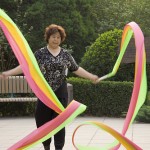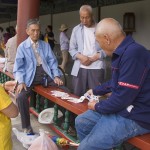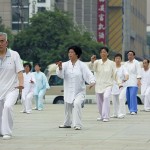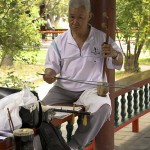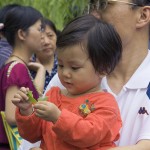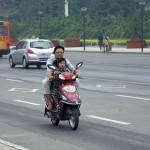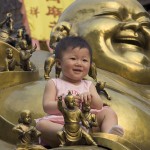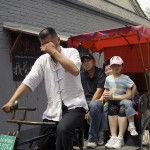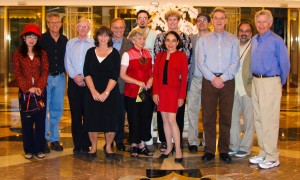See more photos related to this blog post at this flickr page.
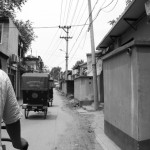 On Monday, June 2, 2008, my first full day in Beijing, I got into a pedicab with Leo Goodman.We were being taken through the hutongs of the Shichahai neighborhood to have lunch in a family’s home. A sign for tourists in that neighborhood reads in both Chinese and English: “Hutong refers to the unique old alleys in Beijing. The word, which derives from Mongolian, was brought to Beijing over 700 years ago, when the Yuan Dynasty built Badu here.”
On Monday, June 2, 2008, my first full day in Beijing, I got into a pedicab with Leo Goodman.We were being taken through the hutongs of the Shichahai neighborhood to have lunch in a family’s home. A sign for tourists in that neighborhood reads in both Chinese and English: “Hutong refers to the unique old alleys in Beijing. The word, which derives from Mongolian, was brought to Beijing over 700 years ago, when the Yuan Dynasty built Badu here.”
I was pretty excited to be in this neighborhood, because I’d seen photos taken by two of my favorite photojournalists, Sean Gallagher and Zoriah, of the destruction of the hutongs in Beijing. 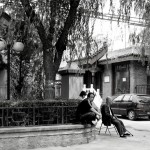 But here I was being pulled by a man driving a big tricycle through a very real and very attractive neighborhood. It became clear to me that this neighborhood had been preserved and restored, while others had been destroyed. There were many new cars parked on the streets and signs of new construction everywhere.
But here I was being pulled by a man driving a big tricycle through a very real and very attractive neighborhood. It became clear to me that this neighborhood had been preserved and restored, while others had been destroyed. There were many new cars parked on the streets and signs of new construction everywhere.
When we stopped at our luncheon place, I noticed a sign out front that advertised “Chinese Famous Snack: DonkeyMeatSausage.” 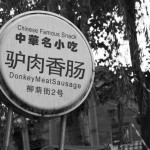 The food was delicious; I don’t think they served us that particular delicacy. The two-room residence where we had lunch was rented for about $75 a year from the government by a couple who had raised their children there. They were both retired now, living on a government pension, and supplementing their income serving lunch to tourists. They were fortunate that they had running water and their home opened onto the street, giving them a front porch. Other families rented the other homes in the courtyard residence.
The food was delicious; I don’t think they served us that particular delicacy. The two-room residence where we had lunch was rented for about $75 a year from the government by a couple who had raised their children there. They were both retired now, living on a government pension, and supplementing their income serving lunch to tourists. They were fortunate that they had running water and their home opened onto the street, giving them a front porch. Other families rented the other homes in the courtyard residence.
After returning from China, I learned some of the history of the hutongs by doing some web research on Wikipedia and followed other links; parts of this blog are lifted from those sources. During the long dynastic periods of Chinese history, the Forbidden City was placed at the center of Beijing, and was surrounded by two concentric circles, called the Inner City and the Outer City. The higher your status, the closer you could live to the center of the circles. Aristocrats and wealthy merchants tended to live to the east and west of the imperial palace. The working class and lesser merchants lived to the north and south. 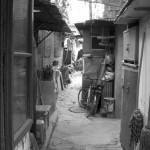 The typical homes, called siheyuan, were built around courtyards. The four buildings of a siheyuan were normally positioned along the north-south and east-west axes, with passages separating the buildings and connecting to the courtyards. All of the rooms around the courtyard had large windows facing onto the yard and small windows high up on the back wall facing out onto the street. The entrance gate, usually painted vermilion and with copper door knockers, was usually at the southeastern corner, and a pair of stone lions was sometimes placed outside the gate. The alleys from which one entered the siheyuan were called hutongs. The hutongs in the wealthy areas were orderly, and lined by spacious homes and walled gardens. The working class neighborhoods had more haphazard hutongs, which were narrower with many turns and angles. The siheyuan on these were of course smaller and simpler.
The typical homes, called siheyuan, were built around courtyards. The four buildings of a siheyuan were normally positioned along the north-south and east-west axes, with passages separating the buildings and connecting to the courtyards. All of the rooms around the courtyard had large windows facing onto the yard and small windows high up on the back wall facing out onto the street. The entrance gate, usually painted vermilion and with copper door knockers, was usually at the southeastern corner, and a pair of stone lions was sometimes placed outside the gate. The alleys from which one entered the siheyuan were called hutongs. The hutongs in the wealthy areas were orderly, and lined by spacious homes and walled gardens. The working class neighborhoods had more haphazard hutongs, which were narrower with many turns and angles. The siheyuan on these were of course smaller and simpler.
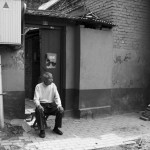 The conditions of the hutongs deteriorated at the end of the Qing Dynasty, and continued to decay through the end of World War II. Siheyuan previously owned and occupied by a single family were subdivided and shared by many households, with additions tacked on as needed, built with whatever materials were available. The 978 hutongs listed in Qing Dynasty records swelled to 1,330 by 1949. Following the founding of the People’s Republic of China in 1949, many of the old hutongs disappeared, replaced by the high rises and wide boulevards of today’s Beijing. Demolition continued at a faster pace starting in the 1990s, as Beijing modernized, and then accelerated again in the 21st century as China prepared for the 2008 Olympics.
The conditions of the hutongs deteriorated at the end of the Qing Dynasty, and continued to decay through the end of World War II. Siheyuan previously owned and occupied by a single family were subdivided and shared by many households, with additions tacked on as needed, built with whatever materials were available. The 978 hutongs listed in Qing Dynasty records swelled to 1,330 by 1949. Following the founding of the People’s Republic of China in 1949, many of the old hutongs disappeared, replaced by the high rises and wide boulevards of today’s Beijing. Demolition continued at a faster pace starting in the 1990s, as Beijing modernized, and then accelerated again in the 21st century as China prepared for the 2008 Olympics.
The extent of destruction of siheyuan is startling. Today, the area occupied by siheyuan has shrunk from 17 million square meters in the early 1950s to just three million square meters. For example, between only 1990 and 1998, a total 4.2 million square meters of old housing was destroyed. The Beijing Yearbook 2003 reported that more than 60 hutongs vanished during 2002 alone, and the Beijing Municipal Construction Committee stated in 2004 that some 250,000 square meters of old housing – 20,000 households – would be demolished in 2004.
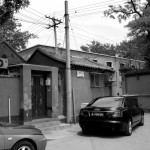 According to the Beijing Municipal Administration of Cultural Heritage, there are over 3,000 “well-preserved” courtyards remaining in Beijing, and over 539 are in Cultural and Historical Conservation Areas, including those found in the Shichahai Lake neighborhood we visited. In 2004, the Beijing Municipality began encouraging the sale of siheyuan, including the real estate, in order to protect the remaining hutong areas. Many of these are for sale, and are being bought and renovated by foreigners, including wealthy developers from Hong Kong and Taiwan. More typically, however, siheyuan are being used as housing complexes, hosting multiple families, with courtyards being developed to provide extra living space. The living conditions in many siheyuan are considered squalid, with very few having private toilets.
According to the Beijing Municipal Administration of Cultural Heritage, there are over 3,000 “well-preserved” courtyards remaining in Beijing, and over 539 are in Cultural and Historical Conservation Areas, including those found in the Shichahai Lake neighborhood we visited. In 2004, the Beijing Municipality began encouraging the sale of siheyuan, including the real estate, in order to protect the remaining hutong areas. Many of these are for sale, and are being bought and renovated by foreigners, including wealthy developers from Hong Kong and Taiwan. More typically, however, siheyuan are being used as housing complexes, hosting multiple families, with courtyards being developed to provide extra living space. The living conditions in many siheyuan are considered squalid, with very few having private toilets.
Being a professional “peeping Tom,” as C. Wright Mills called social scientists in The Sociological Imagination, I wasn’t satisfied with my pedicab drive through the restored Shichahai neighborhood. Where were the “real” hutongs? Passing up a trip to a jade and pearl marketplace late one afternoon, I walked to the Qianmen Hutong, just southwest of Tiananmen Square to get a look. I saw a very busy residential and commercial district, with winding streets and alleys, and many small shops. 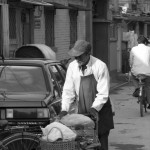 The streets were crowded with neighbors walking and biking home after work. Children were playing in the puddles that had formed from the day’s rain, and elderly people were sitting in chairs suspiciously watching a tall, western tourist with a white hat ask if he could take their picture. Smells from the food stores and small restaurants mixed with less agreeable odors from the old homes and streets and an occasional whiff of sewage. I followed one elderly woman from her home down an alley, passing her as she went into a public toilet. A few other Westerners were spilling out of a youth hostel on one of the more commercial streets, called “Shopping Street” on my map. I remembered staying in similar hotels in Paris during my college days, and I thought of the 5-star hotel I’d be returning to.
The streets were crowded with neighbors walking and biking home after work. Children were playing in the puddles that had formed from the day’s rain, and elderly people were sitting in chairs suspiciously watching a tall, western tourist with a white hat ask if he could take their picture. Smells from the food stores and small restaurants mixed with less agreeable odors from the old homes and streets and an occasional whiff of sewage. I followed one elderly woman from her home down an alley, passing her as she went into a public toilet. A few other Westerners were spilling out of a youth hostel on one of the more commercial streets, called “Shopping Street” on my map. I remembered staying in similar hotels in Paris during my college days, and I thought of the 5-star hotel I’d be returning to.
Old bicycles and new cars were parked on the streets and alleys of the hutong. I surmised that the cars belonged to those residents who had purchased entire siheyuan, while the bikes were owned by those living in the smaller buildings within the courtyards, like the two-room residence in which I was served lunch a few days before. The doors to many of the siheyuan had been left open, and I used my professional “Peeping Tom” status to gaze into them and photograph as many as I could. Typically, a crwded, cluttered alley presented itself that ended in a right angle turn beyond which I couldn’t see. There were often clothes hanging on a line, and many bikes parked there. Occasionally, I’d see a child or adult walking in or out of the alley, and I felt exposed and embarrassed for being an interloper. Didn’t they know I was a professional and allowed to gaze? In smaller alleys I saw a grandfather accompanying a child on a bike with training wheels, a group of men hunched over some kind of board or card game, and many people just passing through as they went about their business in their neighborhood. Overall, about as many people smiled at me as viewed me with suspicion or scorn.
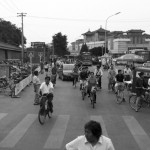 Construction was everywhere. As I approached this neighborhood from Tiananmen Square on the north, I passed a construction site similar to those seen in any big city. Looking through a gap in the wall, I saw a demolished neighborhood similar to those I saw in Zoriah’s photos. Workers were using hand saws and ancient wheelbarrows to build a new neighborhood. When I crossed the street into Qianmen I had to bypass barricades designed to keep pedestrians away from the building activity on the street. Within the hutong itself I also saw occasional open lots with a few men working to restore an old shell of a home.
Construction was everywhere. As I approached this neighborhood from Tiananmen Square on the north, I passed a construction site similar to those seen in any big city. Looking through a gap in the wall, I saw a demolished neighborhood similar to those I saw in Zoriah’s photos. Workers were using hand saws and ancient wheelbarrows to build a new neighborhood. When I crossed the street into Qianmen I had to bypass barricades designed to keep pedestrians away from the building activity on the street. Within the hutong itself I also saw occasional open lots with a few men working to restore an old shell of a home.
I’m thrilled with my solo walk through the Qianmen Hutong looking for the “real” Beijing. Did I find it? I have no way of knowing. But it was surely a closer view than I received from the 5-star hotels and the windows of a tour bus during the rest of the trip. And it provides me with a strong visual memory of the history I read when I got home. I hope my photos give you a sense of my experience.
